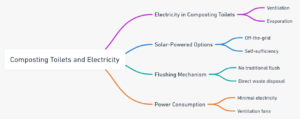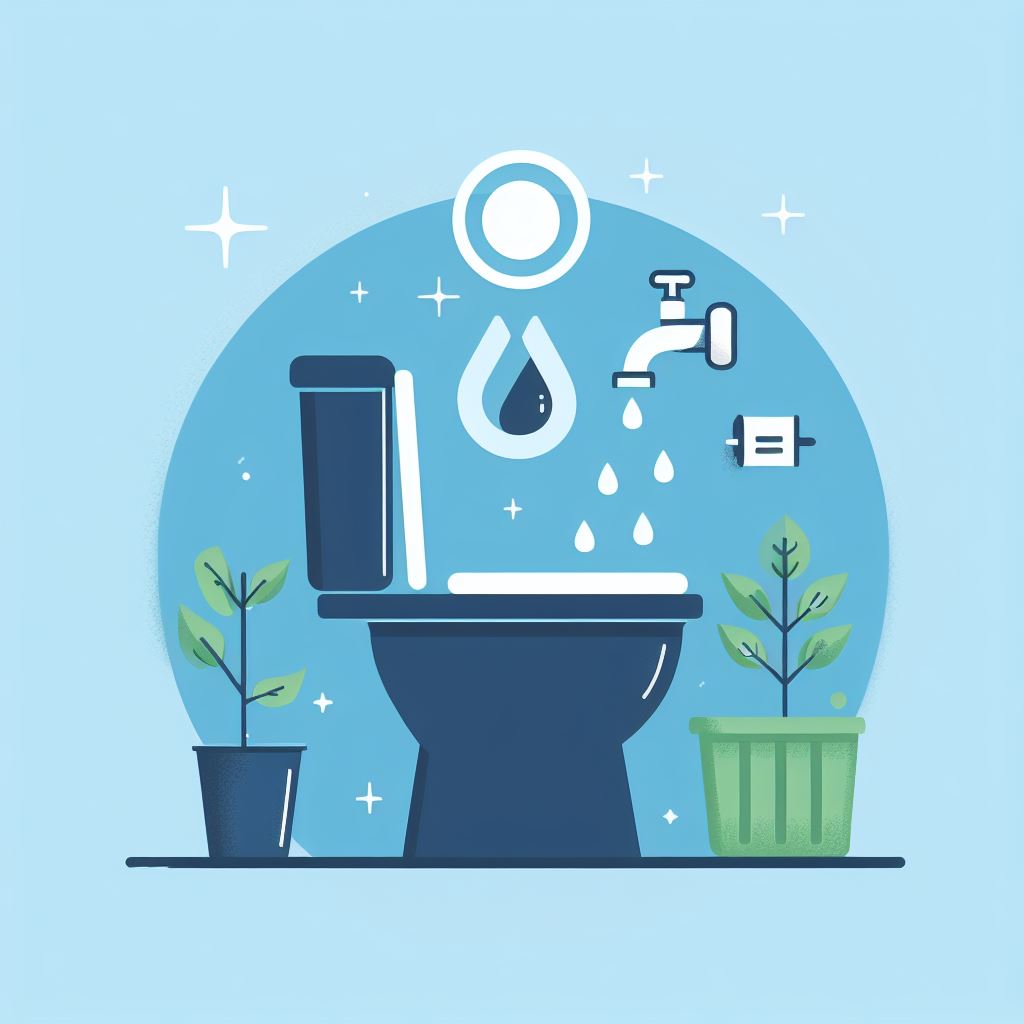Composting toilets have become a popular choice for many homeowners, especially those looking to reduce their environmental footprint. But a common question that arises is: do composting toilets use electricity? Let’s dive into this topic and understand the ins and outs of composting toilets and their relationship with electricity.
[toc]
Key Takeaways:
- Composting toilets can operate with or without electricity.
- Electricity in composting toilets is primarily used for ventilation.
- Solar-powered options are available for off-grid setups.
- Most composting toilets don’t use water and hence don’t “flush” in the traditional sense.
How Does an Electric Composting Toilet Work?
The Need for Electricity in Composting Toilets
Imagine having a compost pile in your backyard where you throw in veggie scraps, grass clippings, and other organic waste. Now, think of placing this pile inside a plastic barrel and pouring water into it daily. Without proper ventilation, this pile would turn into a sludgy mess, unfit for composting. Similarly, composting toilets need ventilation to allow excess liquid to evaporate, ensuring the composting process runs efficiently. This is where electricity comes into play.
Ventilation and Electricity
Just as garden composting systems have ventilation to let out excess moisture, composting toilets also need a mechanism to let out excess liquid. If a composting toilet doesn’t have a ventilation fan running, the compost pile inside can become too wet, killing the beneficial bacteria and organisms essential for composting.
Solar Powered Composting Toilet: An Off-the-Grid Solution
For those who don’t have access to electricity or are looking to be more self-sufficient, solar-powered composting toilets are a great solution. By combining a composting toilet with a solar system, you can operate the toilet without being tied to the grid. This setup is perfect for homes aiming to reduce their dependence on grid power.
Do Composting Toilets Need Electricity to Flush?
A common misconception is that composting toilets need electricity to flush. However, most composting toilets don’t actually “flush” in the traditional sense since they don’t use water. Instead, waste travels directly into the composting chamber. After using the toilet, a small amount of wood shavings or other carbon-rich material is added to aid the composting process.
What type of wood shavings should you use?
How Much Power Does a Composting Toilet Use?
While the exact power consumption varies based on the model and usage, composting toilets generally use a minimal amount of electricity, primarily for the ventilation fans. These fans help in evaporating excess liquid, ensuring the compost remains at the right moisture level.
Watch Video: Composting Toilets: How Do They Work?
Making it Simple: Analogy and Metaphor
Analogy: Think of a composting toilet as a mini garden inside your home. Just as plants in a garden need sunlight and air to grow, the compost inside the toilet needs ventilation (electricity) to break down properly.
Metaphor: A composting toilet is like a slow cooker. It takes time to break down waste, and the ventilation (or electricity) acts as the heat source, ensuring everything inside breaks down evenly and efficiently.
Incorporating Tables for Clarity
| Feature | Traditional Toilet | Composting Toilet |
|---|---|---|
| Water Usage | Yes | Minimal/None |
| Electricity | No | For Ventilation |
| Waste Disposal | Sewage System | Composted On-Site |
| Environmental Impact | High (Water Wastage) | Low |
External Resources for Further Reading
Part 2: Delving Deeper into Composting Toilets and Electricity
In the first part, we introduced the concept of composting toilets and their relationship with electricity. Now, let’s delve deeper into the intricacies of how these toilets function, the role of electricity, and address some common misconceptions.
Electricity’s Role in the Composting Process
Maintaining the Right Environment
For composting to occur efficiently, the environment inside the toilet needs to be just right. This means maintaining the correct balance of moisture, heat, and air circulation. Electricity plays a crucial role in ensuring this balance.
The Ventilation System
Most electric composting toilets come equipped with a ventilation system. This system helps in:
- Evaporating excess moisture: Too much moisture can hinder the composting process. The ventilation system ensures that excess liquid is evaporated, leaving behind a perfect environment for composting.
- Odor control: One of the main concerns with composting toilets is the potential for odor. A good ventilation system ensures that any unpleasant smells are quickly whisked away.
Benefits of a Good Ventilation System in Composting Toilets
The Composting Process Explained
To understand how a composting toilet works, let’s look at the entire process from start to finish:

- Use of the toilet: Once you’ve done your business, the waste goes directly into the composting chamber.
- Addition of carbon-rich material: Materials like wood shavings or coconut coir are added to aid the composting process.
- Composting begins: With the right balance of moisture, heat, and air, the composting process starts.
- Electricity for ventilation: The ventilation system kicks in, ensuring excess liquid is evaporated and any odors are removed.
- Compost ready for disposal: After a certain period, the waste is fully composted and ready for safe disposal.
User Interaction with the Composting Toilet
Understanding how a user interacts with a composting toilet can provide insights into its design and functionality.
Choosing the Right Composting Toilet
When it comes to selecting a composting toilet, understanding your needs and the features of different models is crucial.
Solar-Powered Options: A Sustainable Choice
For those keen on sustainability, solar-powered composting toilets are an excellent choice. These toilets harness the power of the sun to run their ventilation systems, making them perfect for off-grid setups.
Advantages of Solar-Powered Composting Toilets
Addressing Misconceptions
There are several misconceptions surrounding composting toilets, especially regarding their electricity usage. It’s essential to understand that while some models use electricity, others don’t. The primary purpose of electricity in composting toilets is for ventilation and not for flushing.
Debunking Composting Toilet Myths
Stay tuned for the frequently asked questions section in our next segment, where we’ll address all your queries about composting toilets and their electricity usage!
The Science Behind Composting Toilets
Natural Decomposition at Work
At the heart of every composting toilet is a natural process: decomposition. Just as leaves on the forest floor break down over time, the waste in a composting toilet also decomposes. This process is facilitated by microorganisms that feed on the waste, turning it into compost.
The Role of Beneficial Bacteria
Bacteria play a pivotal role in the composting process. These tiny organisms break down waste at a cellular level, ensuring that the end product is free from pathogens and safe for disposal.
Understanding the Role of Bacteria in Composting
Factors Influencing the Composting Process
Several factors can influence how efficiently a composting toilet works:
- Temperature: The composting process is most efficient at temperatures between 90°F and 140°F. Outside this range, the activity of beneficial bacteria can slow down.
- Moisture: A moisture content of around 50% is ideal for composting. Too much moisture can create a sludgy mess, while too little can dry out the compost, slowing down decomposition.
- Air: Oxygen is essential for aerobic bacteria, the primary decomposers in a composting toilet. Without adequate air circulation, the composting process can become anaerobic, leading to unpleasant odors.
Maintenance and Care
For a composting toilet to function optimally, regular maintenance is crucial:
- Regularly add carbon-rich material: Materials like wood shavings or coconut coir help balance the nitrogen-rich human waste, ensuring efficient composting.
- Empty the compost bin: Depending on usage, the compost bin will need to be emptied periodically. The end product is a nutrient-rich compost that can be safely disposed of or used in gardens.
- Clean and inspect: Regularly clean the toilet bowl and inspect the ventilation system to ensure it’s working correctly.
Composting Toilet Maintenance Tips
Environmental Impact and Benefits
Composting toilets offer several environmental benefits:
- Water conservation: Traditional toilets use gallons of water with every flush. In contrast, composting toilets use little to no water, conserving this precious resource.
- Reduced sewage: By composting waste on-site, the need for sewage treatment is reduced, decreasing the environmental impact.
- Nutrient recycling: The end product of a composting toilet is nutrient-rich compost that can be returned to the earth, completing the nutrient cycle.
Environmental Benefits of Composting Toilets
Addressing Concerns and Misconceptions
While composting toilets offer numerous benefits, they are often met with skepticism. Common concerns include:
- Odor: With proper ventilation, composting toilets are virtually odor-free.
- Sanitation: The composting process kills pathogens, making the end product safe for disposal.
- Complexity: Modern composting toilets are user-friendly and require minimal maintenance.
Addressing Composting Toilet Concerns
In conclusion, composting toilets are an eco-friendly alternative to traditional toilets. By understanding their workings and benefits, homeowners can make informed decisions and contribute to a more sustainable future.



